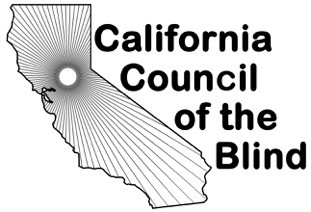by Jeff Thom
I've written quite a few columns for the BC during my years as president, but I can't remember any exclusively concerning our senior population. I'd say
it is more than about time!
Much has been made about the problems we face in the California Council of the Blind and for that matter the American Council of the Blind because of the
graying of our membership. However, as with so many things in this complex world of ours, there are negatives and positives to this trend. Because our
membership is increasingly 50 and above, we more closely reflect the majority of persons who are blind or have low vision in that more than half of those
with significant vision impairments are 55 and over. This can be a positive in that it will hopefully energize our organization's attempt to advocate specifically
on behalf of seniors who are blind or have low vision.
I could probably write a book about the myriad of problems that seniors with vision impairments face. As an example, changes in federal rehabilitation
statutes are creating serious concerns about the ability of state rehabilitation agencies and private providers of specialized services for our senior
population to continue rendering even their current level of services, let alone to meet all the unmet need in this area. In this column, however, I want
to focus on services, or more correctly the lack thereof, that our seniors need that are of more general applicability to the senior population. After
identifying some of the programs and services that fall far short of meeting the needs of our senior population, I want to explore what we can do in order
to begin to address this problem.
Senior centers provide recreation, socialization, and other opportunities for seniors to avoid the isolation that so often plagues this population. Yet
it is the exception, rather than the rule, for senior centers to know how to work with the blind and low vision population that comes through their doors.
Increasingly, seniors, including those with vision loss, need housing and homeless assistance. In the case of homeless shelters, rules often militate against
serving persons who are blind, and in other cases the biases of those operating these facilities cause them not to want to serve our population. As we
age, the likelihood that we will need residential care in a nursing facility or residential care facility for the elderly increases. Whether it is having
access to information on everything from menus to upcoming events, learning to navigate around a facility, or coping with socialization issues that can
arise for persons suffering recent vision loss, these and other issues create serious problems for nursing facility residents with vision impairments.
Of course we haven't even talked about the health care system, physicians, hospitals, clinics, etc. This is far from a complete list, but you get the point.
So what can we do to address this service gap? Preliminarily, I would note that the aging community is beginning to understand the need for cross-pollination
with the disability community. However, when the aging infrastructure thinks about the disability community and from whom to seek input, they turn to the
independent living centers. Most independent living centers do not have the expertise with respect to people with vision loss, and even those who do concentrate
on a more disability-wide approach.
As I see it, however, CCB and the larger advocacy community and the network of private specialized service providers for persons with vision impairments
can and must play a far more active role. As a first step, and it will not be an easy one to accomplish, we have a huge educational effort ahead of us.
We need to begin to educate legislators and state officials, such as those in the Department of Aging and the Commission on Aging, about the need to better
integrate our senior population into the programs that serve all seniors. At the local level, we need to inform county officials and those involved in
local area agencies on Aging about our concerns. These area agencies on aging have much to do with the dissemination of local program funds. Often they
distribute funds to local programs and can be excellent resources for the distribution of information. Similarly, we must work with lobbying organizations
that represent interests such as nursing facilities, hospitals, and clinics to begin finding ways of disseminating information.
There will, of course, be situations that require more than education. We must be prepared to advocate for change when it is clearly necessary. As just
one example, employee training requirements about the needs of our population is an area that cries out for legislative or administrative change.
It is beyond doubt that changing the way that services are provided to seniors to better meet the needs of our blind and low vision population is a truly
daunting task. However, the California Council of the Blind has never shrunk from tackling seemingly impossible challenges, and I feel confident that we
will, with our partners in the field, rise to this challenge as well.


